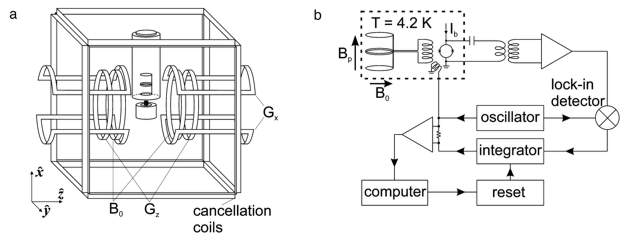During his sabbatical, Bennie ten Haken worked on the challenging area of the application of SQUID sensors to perform MRI at extremely low fields (~100 μT) the SQUID group in Berkeley. The most important results of this work are published in:
“Microtesla MRI with a superconducting quantum interference device”
Robert McDermott, SeungKyun Lee, Bennie ten Haken, Andreas H. Trabesinger, Alexander Pines, and John Clarke, PNAS 101 (2004) pp 7857-7861.

The experimental setup for SQUID-MRI at ~100μT as used by the Berkeley group.
A superconducting antenna has only a noticeable advantage in MRI when the noise of the sample (e.g. human body or a part of it) is small compared to the noise coming from a “normal” antenna. A relatively straightforward SNR analysis shows that this condition is only met with a small sample or antenna (smaller than 10 mm), or at low fields (far) below 100 mT. MRI microscopy with superconducting materials is successfully demonstrated on the skin, but also possible on the veins near the surface (e.g. MR-angiography) or on the eye, tongue, teeth etc. There are also interesting perspectives for research on other subjects: e.g. cancer research on small animals and artificially grown tissue.
MRI at field levels below 100 mT has no clinical relevant applications at present, but there is a continuous demand for extremely open or hidden MRI systems that could be developed if MRI would be feasible below 100 mT. At present there are a few options that could enable such a technology: Hyper-polarization with optical pumping, the Overhauser effect and pre-polarization with an extra coil set. The first two options are investigated in several research groups in Europe and elsewhere. There is only little attention for the third option, but the complications to develop suitable contrast agents for the other two methods justify more research on pre-polarization with a (superconducting) coil, in particular in combination with a superconducting antenna.
